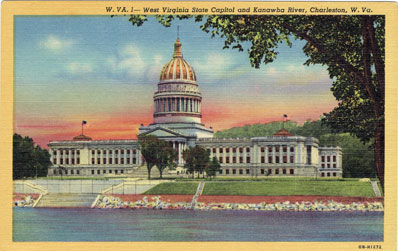This vintage postcard shows the West Virginia State Capitol on the Kanawha River in Charleston, West Virginia.
Originally, West Virginia was part of the state of Virginia. After the American Civil War, Abraham Lincoln the area that is now West Virginia status as its own state in recognition of the loyalty to the Union of most of its citizens.
The first capitol in 1863 was in Wheeling, West Virginia. Wheeling has a long history as holding some of the first European settlers in the area when the Zane family and others built Fort Henry in 1774 in what is now Wheeling. During the early years, the settlers survived friendly and hostile relations with Native American tribes, the British, and the French at different times. They would gather in the fort when under attack and then go back to their farms during more peaceful times.
During one such attach, in September 1782, Fort Henry was besieged by the British and their Native American allies. Most of the families were in the fort, while General Zane and some of his men were in his nearby home under siege as well. The men at the fort numbered about 20 fighting against 50 British regulars with some 250 Native warriors. The men at the fort were running out of gunpowder so Betty Zane volunteered to go to her home for more powder with the thought that the British wouldn’t shoot a woman. This was true on the way to her home, but during the return trip she was fired at but ran back to the fort unharmed with gunpowder under her apron. She was successful and helped save her friends within the fort as the attackers withdrew two days later.
So, with such a colorful history, Wheeling became a good first choice for the state capitol. But in 1870, it was moved to Charleston by vote of the legislature. Then the capitol moved between Wheeling and Charleston until 1885 when the governor declared Charleston the permanent capitol city and the legislature met in a wooden building for some time.
In 1924, West Virginia began building the current capitol shown in this postcard. Architect Cass Gilbert designed the limestone structure and was so pleased with it that he used the same chamber design for the United States Supreme Court. The United States Supreme Court chamber is a larger version of the one found in the West Virginia Capitol’s East Wing.
The building faces the Kanawha River and the grounds include many statues including Abraham Lincoln.
